-
my mother’s art studio
Hannah, a writer and good friend of mine, once mentioned to me the memories of her mother’s independent afternoons spent painting. Knowing her family was large and homeschooled, I was intrigued to imagine such a vision. I also sensed Hannah’s fondness of these memories and felt I had to know more! For those that homeschool now, hearing memories from a child’s perspective can be a soothing balm to the constant evaluation and re-evaluation that goes on in one’s mind.
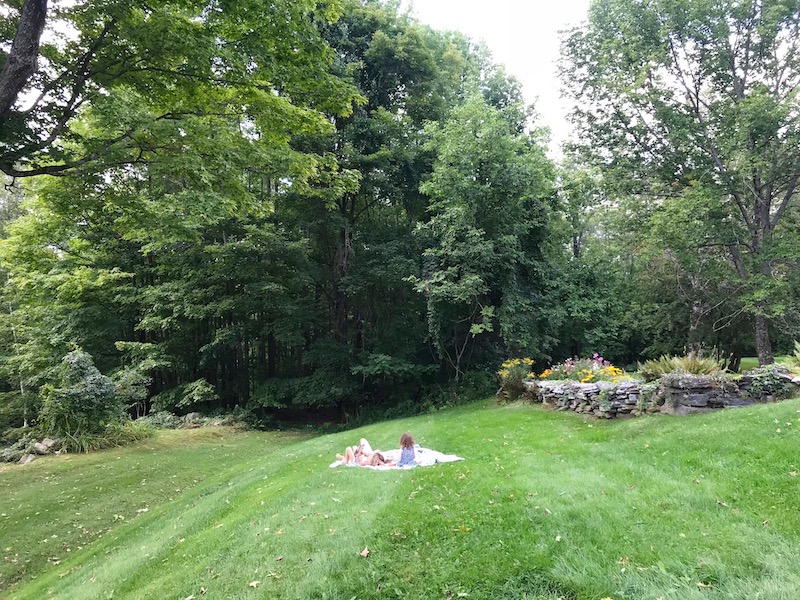 by Hannah Piecush
by Hannah PiecushWhen I was seven my family moved from a New England town with sidewalks and shops to one in the woods. We rented an old white parsonage–although my father was an engineer and not a minister–with a grassy backyard edged by a tumbled stone wall, sugar maples, and a dark row of hemlock trees. The house had enough bedrooms–at last–for all five of us children and a small room at the top of the stairs, with a window looking over the back lawn, that was my mother’s art studio.
The studio was big enough for a wide desk and had shelves where my mother kept her calligraphy pens, boxes of pen nibs, jars of ink, tubes of watercolor pigment, paper of all different textures.
Sometime after our move, my mother arranged for mother’s helpers to come watch the older children in the afternoons while the baby slept and she disappeared into her studio.
These girls were probably only ten or eleven, but they seemed so much older than I was. They taught us which things we could eat in the woods–wintergreen berries and clover flowers–and when to look for wild strawberries in the grass. They answered my questions about whether or not bears might come into our yard. One of them was taken with the idea of going caving and we spent hours in the shade of the hemlock trees, where the branches drew over us like a tent, pretending we were deep underground.
I don’t know how many afternoons a week the mother’s helpers came, but I felt a kind of pride even then that my mother, the artist, was up in her studio where she wrote in calligraphy and painted. Just like I was proud that she was a runner, that she ran in the mornings before I woke up.
When my parents met in college my mother says her plan was to be an artist who lived in New York City and to maybe to compete in the Olympics. She was studying art then and on an athletic scholarship in field hockey and indoor and outdoor track. Then she and my father decided instead to have a lot of children. They decided to homeschool us–even though no one had heard of that at the time.
The story of what she originally planned to be was part of our family legend. Never a story told with bitterness or regret, but one that we, her children, told authoritatively to our friends. We always knew my mother could have been quite happy doing something other than raising a band of children. She’s the kind of woman who invents community wherever she goes, who comes out of a convenience store (we used to wait in the car) beaming from whatever interaction she had inside. We were lucky we got her.
-
Having a family might not come as easily as we had planned.
I have written here before that with each pregnancy I feel a deep sisterly mourning with the others in the room: those waiting for their baby. Statisticians believe that of known pregnancies 20% end in miscarriage and that one in four women will experience one in her lifetime. And there are reasons to believe that the number is actually much higher. I am grateful for this chance to walk beside my friend Susie in her experience, as a reader, through her story.
a note of introduction from Susie (susannawales@gmail.com ): I wrote this essay about infertility and miscarriage nearly four years ago now. I was scrambling for ways to express a grief so often unnamed and to come to terms with my suffering. I sought out many books during those years, some of which were immensely helpful, namely A Grief Observed by C.S. Lewis, Walking with God Through Pain and Suffering by Timothy Keller, and The Hardest Peace by Kara Tippetts (a new documentary about her story was just released). In my experience, the pain of miscarriage doesn’t go away, but it does dull and it does recede. Since that difficult time, I have had the joy of becoming a mother through adoption twice over to two beautiful boys: Victor is now three and Bastion is one-and-a-half years old. I have been astonished at the Lord’s faithfulness to me, and I hope that this description of my journey brings comfort to someone who has likewise suffered.
Content warning: the following beautiful and honest essay contains explicit descriptions of miscarriages. Please evaluate your emotional and mental state before reading, for example whenever pregnant I avoided stories of pregnancy and birth complications.–RR
 by Susie Wales
by Susie WalesAs a newlywed back in 2012, whenever I pictured my life five, ten, or fifteen years down the road, kids were always in the frame. I am the fifth of seven children and my husband Ben is the second of five. We both wanted children and expected to be expecting by our second year of marriage. Then, a couple of months shy of our first anniversary, I miscarried at six weeks. We hadn’t even been trying to conceive but were elated nonetheless that I was pregnant. Then a few days after a blood test confirmed a positive pregnancy and my OB/GYN doctor examined and congratulated me, I miscarried at home. Almost as soon as we had time to cheer, we had lost the baby.
I sat on the toilet and bled, painfully passing bits of tissue. I turned and looked into the toilet for signs of life and scooped up a shiny translucent mass of tissue. I held it in the cupped palm of one hand and gently probed at it with my other index finger, clearing the blood away. My breath quickened. I tore a square of toilet paper from the wall and swaddled the lump of tissue in it. I stood in silence a few moments, the tiny tissue quivering in my shaking hand. Then I lowered it down into the toilet and flushed. “I think I just bled out our baby,” my voice cracked as I shared the news with Ben on the phone. Upstairs under my bed covers, I rocked from side to side and cried.
Three months later, we conceived again and the baby held on for ten weeks before passing in a rush of bright red clots that disappeared down my shower drain. Suddenly, we had bereaved the loss of two children and felt a weight we hadn’t anticipated. Having a family might not come as easily as we had planned.
Though the miscarriages were painful, we were hopeful we would conceive. After all, those pregnancies had come without strategizing, so now that we would pay closer attention, we thought we would get pregnant in no time. But after the fourth month of trying to conceive without positive results, we consulted an endocrinologist. He discovered I have a condition called Factor V Liden, so I may be prone to clotting, which would make any pregnancy more risky. I left those appointments feeling more discouraged than when I had entered. Keep having regular intercourse, he advised, and try using an ovulation predictor kit.
I hoped that each month would be the one. After each conception window passed, I listened for my body to give me signs of life. When my breasts were sensitive and full, I wondered, “Are they getting ready to nurse a baby?” With every twinge of hunger, I hoped. Was the bloating and cramping just my body readying itself for a growing life? I flipped the calendar to the season in which I’d be nearing the end of my pregnancy and pictured fanning myself in the heat of July or bundling up mid-December. I browsed the “Names I like” document I kept on my computer. I thought about driving to the maternity clothing store in a strip mall nearby, just to look. I dreaded using the bathroom and then sighed with relief when there were no drops of blood in the bowl.
Then month after month, the periods came. On one of those first several months, in the early morning darkness, I awoke to cramping, and stepped to the bathroom. My bare feet recoiled when they met the cold tile floor. I eased onto the toilet, my elbows propped on my thighs, and bled. I slipped back under the comforter and buried my face in Ben’s shoulder. He stirred. “Bleeding?” he asked. “It’s…so sad,” I whispered. We repeated this refrain each month as my periods came. And each month, the dreams I had nursed over the previous two weeks dissipated like morning mist.
During my first two years of trying to conceive, it seemed every woman around me was pregnant. At that time, my two closest friends from college were each on their second babies. All five of my sisters in law had just had babies or were expecting. Ben’s friends from college—all younger than me–continued to share their joyful news. Genuinely excited at first, I soon succumbed to self-pity and jealousy.
I felt a dissonance with my body that I hadn’t previously experienced. I have nurtured children most of my life through babysitting, teaching, being an aunt–yet when I wanted to carry my own children, my body seemed to be stopping me. I stood at my bathroom mirror with my hands pressed on either side of the sink and asked my red-eyed reflection, “What is wrong with you?”
During the summer of that second year of trying to conceive, we moved from Virginia to Michigan and started with a new fertility center. After tests ruled out endometriosis, the doctor prescribed timed intercourse and ovulation predictor kits. Back to that familiar recipe: we tried for a few months to no avail. With the new year came a greater sense of urgency and we moved to the next level of treatment. We were introduced to Intrauterine Insemination (IUI). This procedure increases the odds of conception as a doctor places the male’s sperm deep inside the female’s uterus where it will have higher chances of forming an embryo. We were optimistic.
Then after six straight months of failed treatments, we decided to stop and try on our own again. These treatments were getting costly and my heart ached with each disappointment. We took a break from intervention and hoped for a natural conception.
Then six months later, amidst the bustle of Christmas excitement, I realized I was a few days past my monthly period. The next morning I took a pregnancy test and blinked at the two strips on the test: positive. I clapped my hand over my mouth and rushed to call Ben with the news. Could we really be pregnant? I knew I should be cautious, but my giddiness over seeing a positive after years of negatives cast a hopeful spell over my doubts.
For the next month I gave myself shots of blood thinner into the pinched flesh of my stomach each night. The doctor prescribed these Lovenox shots to keep my Factor V Liden blood clotting in check. Each night I ripped open an alcohol swab, rubbed it over my belly, breathed deeply, put in the needle, pressed the plunger down, and pulled the needle out. I had a cold wash cloth ready to apply and gently press over the spot of injection that stung and burned for a minute or so. It took some practice, but after a couple of weeks, I got through the whole routine without stalling. I took five deep breaths and cheered myself on: “Ok, it’s ok, everything’s ok, you can do it.” It usually took between one and five minutes to gather the nerve and then it was over. It may not be easy, but this pregnancy was progressing, hope was growing.
Two days after my eight week ultrasound, I traveled with Ben to Ohio where he was slated to work a trade show for his company, which sells flavors to the food and beverage industry. We drove five hours to our hotel, wheeled suitcases to our room and Ben eased onto the bed while I headed to the bathroom. When I went to flush the toilet, I noticed three little red drops in the bowl. My chest tightened. I flushed and stepped out to tell Ben I was spotting. While passing bits of blood is fairly normal during the first trimester, I knew that for me, it always preceded a miscarriage. We sat together on the bed, wordless.
The next morning I felt optimistic. I used the toilet and it was blood free when I flushed. After dropping Ben off at his convention center, I drove to a library a few miles away. I arrived about twenty minutes before it opened, parked my car, and dialed my fertility doctor. My shoulders immediately relaxed when I heard the warm, reassuring voice on the other end, “Spotting is very common at the point in your pregnancy.” She said not to worry and planned to see me first thing Monday morning to make sure everything was ok. I smiled into my phone, relieved.
In the library, I found an empty table next to large bay windows that cast squares of light onto the carpet. I set up my laptop and opened up an essay for an MFA program for which I was applying. The essay was about infertility and the despair I felt because of it. Even though I had spotted the night before, I decided to replay the doctor’s calm words in my ears “this is very normal.” It had been a few months since I’d opened this particular essay about grief and loss. Newly pregnant, I felt I was looking back at the tear-filled writer with compassion. I wanted to offer her the same reassuring voice I’d just heard on the phone and soothe her fears. Although I knew miscarriages usually occur within the first trimester, I was already beginning to feel that this pregnancy was different, spotting and all. We had tried for so long for this one, I thought, this baby will come. I think it’s a boy.
It was after lunch while I was sitting in the children’s section of the library when a sudden a pain shot through my lower back. I slipped my laptop into my backpack, slung one strap on my shoulder and hurried to a large, one-stall bathroom at the back of the library. I sat down on the toilet and began bleeding profusely. Large clots came fast. I felt myself lift up and detach, floating above in the ceiling watching myself. I didn’t cry, I didn’t even whimper. I pushed my fingers hard against my tailbone as each rush of blood and tissue came. I leaned forward and then sat upright, rocking slowly back and forth, back and forth. I pressed fingertips to my temples and breathed. When there was a break in the bleeding, I pulled toilet paper from the wall, winding it around one hand so that it looked mummified. Then I stood and stuffed the toilet paper between my legs to catch any blood. I reached up to flush the toilet – now piled with clots. I reached my hand up to pull the lever when something made me hesitate. I reached into the toilet bowl, grabbed an in-tact mass of tissue. It glistened and quivered, sliding through my fingers. I gently laid it down on the floor.
I stared at the mass of blood and started to shake. It wasn’t just a lump of crimson tissue. It was my boy’s broken body. I could cradle him in my hands, walk back through the library, out to the withered flower garden by the parking lot, dig up the cold earth and bury him there. I could kneel at his grave and weep. But I couldn’t leave the bathroom with him, not with my body bleeding and my pants around my ankles. What could I do? My phone – where’s my phone? I fumbled through the pockets of my back pack with my one clean hand, grabbed my phone and took a picture of the mass on the floor. You couldn’t tell how big it was so I placed one hand, palm down, on the tile floor next to it. There was no open casket, no eulogy, but at least I had captured physical proof of my baby’s life. Ultrasounds had showed black and white pictures of his tiny frame, but here I held his bleeding body in my own hand. I scooped it up, released it into the toilet, and began to mop up the floor with toilet paper. I kept filling the toilet with bloody toilet paper and flushing and flushing it.
Tears blurred my vision now; they slipped off my chin, into my ears, down my neck. Snot covered my lips. I ran the faucet over my hands until the water ran clear, digging blood from under my fingernails until my finger pads started to prune. My eyes were stinging now. I raised a shoulder to wipe my nose again and again. I tugged my tight jeans back on and with trembling fingers pulled at the zipper on my coat. I stared at the ceiling, at my sobbing reflection in the mirror. I had returned to myself. I pressed the hot sides of my face and took deep breaths. I was going to have to exit the bathroom, wind my way through the library, and drive the ten miles to the convention center and tell Ben what was happening. I was going to need to keep my composure.
I sat in my parked car at the convention center a few minutes, wiping my nose, then made my way to Ben’s booth. I wound around tables with samples of candy, slushy machines whirling blue raspberry splurpies in circles, and self-serve ice cream machines. It smelled like a carnival and it made me want to vomit. I walk slowly up to Ben and breathed the news in his ear. His face fell and his eyes reddened, “I’m so sorry,” he whispered. We stared at each other for a long moment, then my eyes began to burn. I retreated to the hotel bathroom stall and bled – the clots coming in waves. My body was more in shock than in pain, frozen under the spell of a trauma it was enduring for the third time.
Half an hour later, we started the five-hour trip home. We stopped at a rest area when the blood was soaking through everything and wouldn’t stop. I waddled up to the front doors of the little building, one hand wedged between my legs. I eased onto the toilet, my elbows jabbed into my knees, and held my weary head in my hands. I released a few more clots and felt some relief. When I stood up, my head swam. I had felt this before—I was about to faint. I whispered through dry lips, “Ben! Ben, Ben, I need help.” I crawled on my hands and knees out of the stall and around the corner towards the door. I summoned a louder voice now, “Ben! I need help!” I clawed at the swinging door and managed to pull it open enough for Ben to hear me where he was waiting in the lobby outside. I fell to the floor, my head thudded onto the tile.
I was lying on my back in the middle of the lobby. It was late, pitch black outside the rest area. No one else was there. Ben peppered me with questions: “Susie, can you hear me? Susie, where are we? Susie! SUSIE!” He was loud and demanding. I shook my head from side to side, mumbling assents. He carried me to the car, laid me in the passenger seat, reached in the backseat and ripped open a plastic container of gummy bears he had picked up at the trade show. “We’re going to get you to a doctor. Keep eating these. We’ve got to get your blood sugar up,” he said as he started the car. I smacked my lips hungrily, chewing and swallowing one gummy bear after the other, relishing the rush of energy, my lips sticky. “Susie, what are you eating?” Ben asked, making sure I was conscious. “Gummy bears,” I said, and smiled despite myself. They tasted so good.
My head throbbed and I still felt light headed but I was coming back to myself as we headed towards an urgent care center about twenty minutes from the rest area. Ben decided to call his parents to let them know what was happening. I heard a couple of faint rings and then his mom picked up, “Hello?” “Hi Mom,” he said. “I want to let you know we lost our baby.” His face twitched. There was silence on the other end at first and then a sigh and moan of, “I’m sorry.” He explained that I was bleeding a lot and we were on our way to the hospital. There was no need to come, we just wanted to let them know. Hearing Ben talk on the phone was like a flashlight piercing the fog. I had spent the last few hours in a haze of shock and now I was feeling the reality: I had miscarried again. It both pained and comforted me to hear him state it so plainly. And I realized in that moment after he hung up the phone, as he stared ahead with his hands gripping the steering wheel, that it was not only my loss but his too.
We reached the urgent care center and Ben carried me in, my legs bouncing as he jogged inside. Someone brought me a wheelchair and pushed me down the hall to a room. I was fully conscious now, and I was exhausted. A nurse put an IV in my arm to hydrate me. I could feel something cold trickle down my arm, then slowly the headache I had the last couple of hours began to subside.
A nurse rolled my bed down the hall to the OBGYN unit and parked me next to the ultrasound machine. Her job was to make sure all of the tissue had been expelled from my uterus during my miscarriage. She stuck a condom-covered, gel-topped plastic wand inside me. My body flinched under the sudden pressure and then relaxed as much as it could as she rolled the wand around my uterus, probing for scraps of the baby I had lost. It felt like an intrusion into a private place, like a cocoon was being torn open and scavenged. She peered into her computer screen and I turned my head to see the grainy, black void.
I had had two ultrasounds in this pregnancy so far—the first was at six weeks. My younger sister was in town and she went to the appointment with me. A large-screened television monitor on the wall across from me showed a blurry, bean-shaped fetus. After the doctor printed and handed me a glossy ultrasound strip, my sister took a picture of me as I pinched the shiny photos, holding them in front of my chest. Later that night I had held a vase of fresh flowers Ben bought me and he snapped a photo—life was blooming inside of me! The next ultrasound was at eight weeks: everything looked normal, the baby was growing on schedule, and its heart was pulsing with life.
Just hours earlier, I had held not an ultrasound strip but the substance of those pictures, the blood and tissue that would later be my baby. I had taken pictures of this lost baby. Now faced with an empty ultrasound image, these evidences became even more important to me. I wasn’t just imagining him, right? He was alive in there. As I laid in my hospital bed and turned towards the ultrasound monitor, there was no head to toe measurement, no blinking heart, no sign of any life at all. The baby that held such promise in its tiny, webbed fingers had vanished. The nurse glanced down at me, moved her hand from the computer mouse to my wrist, and offered in a weary voice, “I’m so sorry.” A tear slipped down my cheek and seeped into a crease in my neck as she silently wheeled me back to my hospital room.
A doctor with eyes like periwinkle marbles came into my room. His voice was kind: “Well the good news is that you passed everything naturally.” That’s how the medical community talks about natural miscarriage – as passing all of the tissue. This sounds like a win, something to celebrate, like I’ve just passed the test or passed over the finish line. But what seems more fitting is lost. “You’ve lost everything, all of the tissue was lost, someone was irretrievably lost.”
Ben and I arrived home around 2 A.M., heavy with fatigue, and fell into bed. The next morning was a Monday. Ben left for work and I got up and showered, dried my hair, put on makeup: simple tasks that felt brave considering yesterday’s events.
I called my sister and five brothers one by one and summarized in a few seconds the heart breaking result of the last ten weeks. My younger sister burst into tears, wishing she could be with me, telling me she didn’t know what to say. I called my brothers. “I’m really sorry,” one said. “I’m so sorry to hear that,” said another. The conversations were brief—they didn’t know what to say or didn’t want to pry. I was glad I told them. A few weeks later, I got a note in the mail from one of my older brothers. Just three years prior he had endured the unthinkable horror of losing his three-year-old son in a drowning accident. His tiny cursive font read, “There are no words to extinguish the grief and anguish of loss.” His words covered me like a healing salve. I was going to be OK.
-
striding towards eating your placenta
I confess I was not brave enough to eat my placenta but I did manage to get it home in a food-safe container and into my freezer–two big steps up from my last birth when I rolled my eyes at the midwife for suggesting I’d want to do anything with that thing. So I was delighted when my sister-in-law agreed to write about her brave entrance into the world of health-rumors and nutritional risky business. I love her medley of honest storytelling and humorous side eye at all the threads we find ourselves googling in this day and age.
Pregnancy: that time in life in which you surprise yourself again and again. The stories of strange, never-before-seen cravings and inexplicable emotions are over-told, but even still, as you watch yourself (your very normal self!) pass through each phase, it really does not fail to shock. But there are even stranger acts pregnancy invites us to than pizza rolls with peanut butter—anyone else google Evening Primrose Oil in the last trimester and stare open mouthed at the screen, reading that you can not only take it orally but also vaginally? Anyone else do it anyway?
I tend to veer on that side of things in general—I can’t resist a totally unresearched, totally natural, and allegedly miraculous supplement or an old wives’ tale that’s researched and “proven” wrong, but still sworn to be true. I’ve only been pregnant once, but the list of the things I tried during those months without (or even despite) conventional advice is pretty long:
- Megadosing vitamin c (8,000-12,000mg per day): for overall health and ~vitality~
- Blending raw frozen chicken livers into my smoothies: basically, it’s a multivitamin!
- Supplementing iodine: to make the baby smarter, of course
- Aforementioned evening primrose oil: two ways, to encourage labor
- Acupuncture during the last trimester: for “sending my energy downward”
- Collagen powder: to prevent stretch marks and perineal tearing
- Ketogenic diet: to prevent morning sickness, gestational diabetes, the afternoon slump
- Incredible amounts of very strong red raspberry leaf tea: for“toning” the cervix
- Eating raw fish, eating tons of fish: for baby’s brain
- Planned a home birth: for all the reasons people do that
Other things I reluctantly tried, but tried nonetheless: eating whole pints of ice cream with my husband just before bed, not exercising or moisturizing my skin a single time, getting out of bed in that way you’re not supposed to for the sake of preventing diastasis recti a hundred times every. single. night.
One strange pregnant-person thing that I knew I’d do from the beginning is also the one that many people tend to be most shocked by. In my second trimester, a friend of ours was over for a Bible study dinner and made a joke about how the wildest thing one might do is eat the placenta, like Brad Pitt and Angelina Jolie! There was such an expectation of communal, fellowship-building shock and horror in the joke; it filled me with such delight to say I absolutely planned to. In a different Bible study, years before, I got to know a pregnant person for the first time in my life. She glowed and glowed and then disappeared for a while, and when she reemerged she had a beautiful baby in tow. One night, less than a month before she delivered, she told us her OB had said it takes three years on average for a mother to restore the nutrients depleted during pregnancy. I’ve never found the research to back that up, but it’s always stuck with me. Sometime later, not in a Bible study, I heard about the practice of placental preservation. My first impression was that the idea of consuming the vessel by which your nutrients are transmitted and depleted seems kind of genius.
One way of categorizing the strange things I love to try is this: low risk, high reward. As of now, there are no known risks associated with consuming the placenta, when it’s properly preserved, and the list of potential benefits is impressive: Replenishing your stores of nutrients. Preventing or aiding postpartum depression. Encouraging faster healing post-birth. There are also claims about stem cell therapy, which I don’t know enough about to go into, but are extremely interesting and nothing but positive. For me, the nutrient repletion is enough. Sign me up.
People do it two ways— dehydration or freezing. There are specialists who dehydrate and encapsulate it for you, so you’re truly just taking an extra capsule every morning. The stem cell benefits are only kept intact if frozen, but for all other purposes, dehydration is absolutely fine. I once ran into my midwives’ birth assistant on the sidewalk. She was carrying a drab little lunchbox with a new mom’s placenta inside to go dehydrate. Actually, you can even dehydrate it yourself in the oven! Though then you either deal with using the powder somehow (think smoothies) or encapsulating it yourself, and that’s probably not the thing you’ll want to spend your time on in those early days.
I decided to freeze mine for the sake of simplicity: I didn’t have to hire anyone, and I didn’t have to bake anything. Homebirth made this infinitely easier for me, but as demonstrated by the lunchbox anecdote, it really can be done any which way as long as you keep it very clean. (By very clean I mean use a brand new zip-lock bag.) The most important thing is to develop a simple plan, to be fully executed by someone other than you. Talk to your healthcare provider about your plan, and designate a specific person to handle the passing of the placenta (from medical table to oven or freezer to your re-possession). Talk to your partner about your plan in case you forget to tell other people your plan. I totally forgot to do this—I had the general plan in mind but didn’t designate anyone or talk to my partner about specifics. So if I correctly recall, my muscles were still spasming from childbirth as I instructed my doula to chop and freeze it. She had never done it before, which I say to demonstrate how truly easy it is to do. My midwife stepped in to explain the process of washing it and wringing it out until it’s a “bubblegum pink color.” So she did that and then chopped it into pill-sized pieces and dropped them into an ice tray to freeze. After they froze, I put them into a zip-lock and back into the freezer. I swallowed 1-3 pieces every day, like a pill, until they were gone.
A final placental anecdote: My husband and I spent the first few years of our marriage living in Northern Ghana where he started an agricultural trading company. We had these massive windows on all sides of our living room, and I decided to start trying to grow some herbs. I had a shelf made by a local carpenter to fit the window that got the most light and gathered some seeds and soil. I spotted some pots along the roadside near our house that looked perfect and took a Ghanaian friend with me to buy them. The woman selling the pots didn’t speak much English, so I essentially mimed to communicate that I didn’t need the lids to the pots. She looked a little surprised. I told her I needed nine of them, and she looked absolutely shocked. The friend I’d brought with me often made jokes with strangers when we were out, so I didn’t think it odd that she was laughing hysterically along with an older woman standing nearby as I loaded the nine pots into the back of my car. As we drove away she just could not get herself together, and eventually she told me why: the pots I bought are made specifically for placentas. Traditionally, new fathers come to the birth site after the baby is delivered to gather the placenta into a single pot, with a lid, and bury it securely. This is rooted in the local religion, which is rooted in superstition, so really, I’m glad that all parties involved were able to laugh. The laughing only stopped when I told her about the plans for my own placenta—she was even more shocked than my Bible study friend who made the Brad Pitt joke. For whatever reason, my herbs never grew more than an inch.

Hannah’s inadvertent collection of placenta pots and cacti pictured in the opening and closing photos.
-
spring’s nests
I interrupt the amazing guest writers I’ve had and will continue to have because it’s very important that you have this recipe in time to grab some candy coated eggs off the grocery shelf. Happy season transitioning.
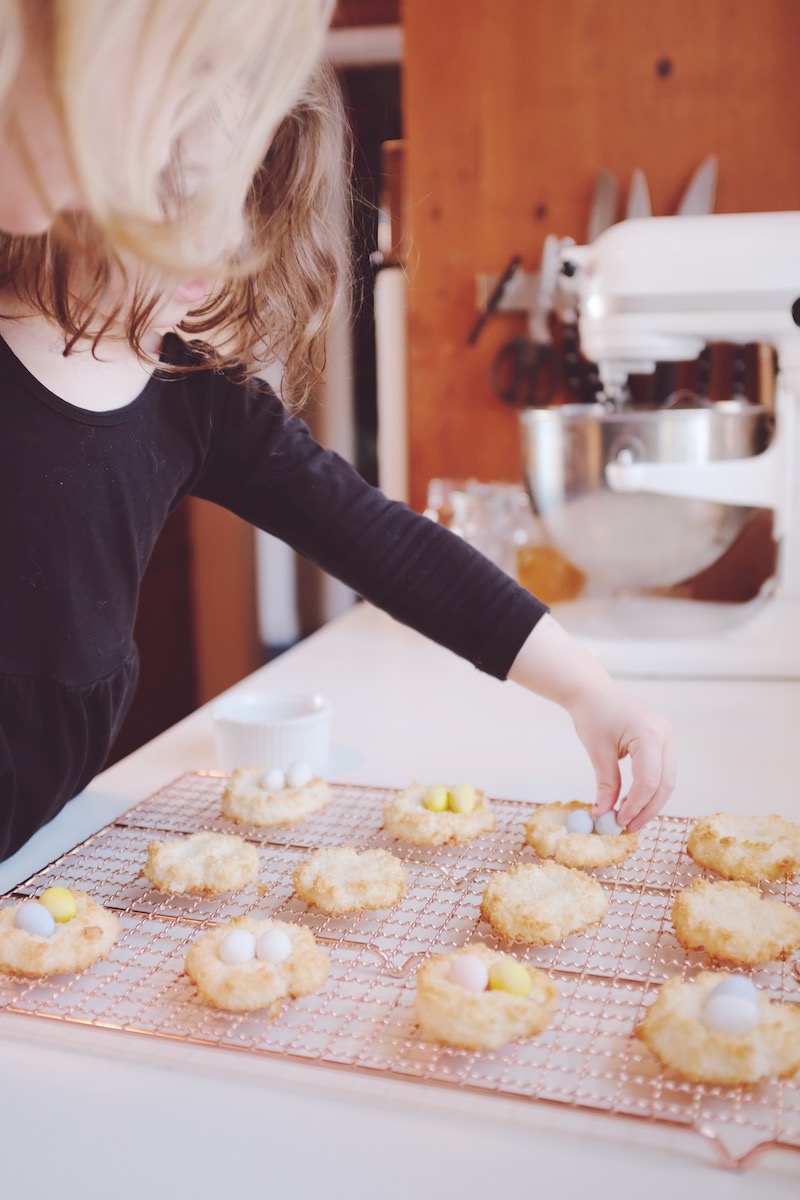
I like what Kathleen Norris writes about the unexpected difficulty of transitioning into bright green spring weather in her book Quotidian Mysteries:
I am always distressed to find how fearfully I confront the glorious prospect of spring and summer, their tantalizing invitation to the out—of—doors and ease of movement. […]
Just as Adam and Eve left Eden in order to take on work that is never finished but must be repeated, so there are spiritual matters that I must contend with over and over again, whenever I am confronted with the genuinely new, even the expected newness of spring. Winter has become a comfortable place to wallow in gloom, my Egypt, the devil I know; but I must cast it off in order to welcome the burgeoning green life out—of—doors.
Though built with zero sense of passing time and an abiding sense that either their birthday or Christmas must be imminent, children seem to have a carefully calibrated inner clock of traditions. This recipe is written in permanent marker on my children’s psychic daybooks and each year around spring they begin to ask, “and when will we make the nests?”
The recipe comes from the dear companion of A Year Between Friends, a book I find myself pulling out at certain times to page through and be gently inspired as we transition into new seasons and new weather.
Their recipe is a more elegant version than what you’ll see on most of the internet. They use unsweetened shredded coconut instead of the sugar-doused goopy coconut. They also suggest using a vanilla bean which adds a black-bespeckled flair, but for my purposes with the kids and how frequently we end up making this recipe in March and April, vanilla extract is simply easier.
Coconut Macaroon Nests
Makes 12 cookies
2 egg whites
1/4-1/2 teaspoon vanilla extract
2 cups //170 grams unsweetened shredded coconut
2/3 cups//135 grams sugar
a pinch salt
1 package candy-coated chocolate egg candy
Preheat the oven to 350. Line a baking sheet with parchment paper.
In a mixing bowl lightly beat the egg whites with a fork just until frothy. Add the vanilla, coconut, sugar and salt. Stir to combine and evenly coat.
Make tablespoon-size mounds of dough on the prepared baking sheet. We like to depress our mounds with the back of a spoon to create the depression for the eggs. Bake until lightly browned, about 15 minutes. Using a spatula, gently transfer the macaroons to a wire rack. While the macaroons are still warm, gently press 2-3 candy eggs into the top of each one to create a nest. Allow the nests to fully cool before serving.
You can see their original recipe using, vanilla bean, here.
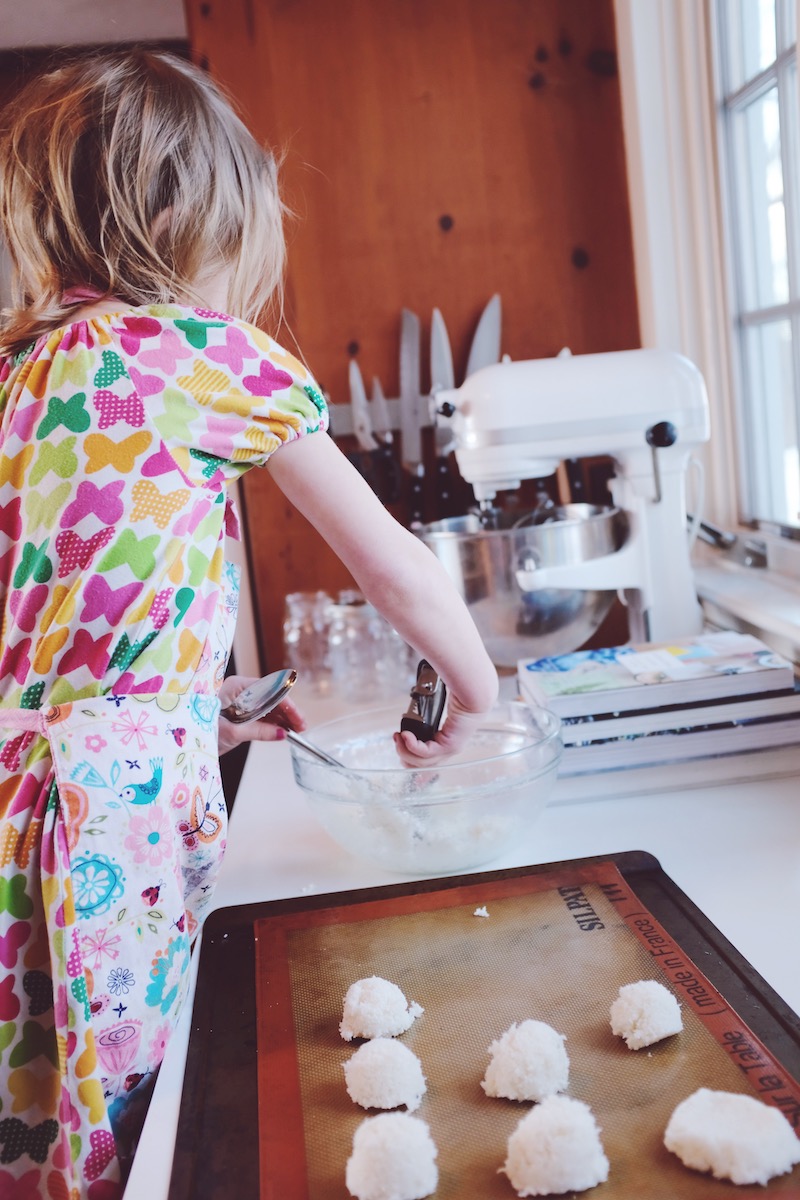
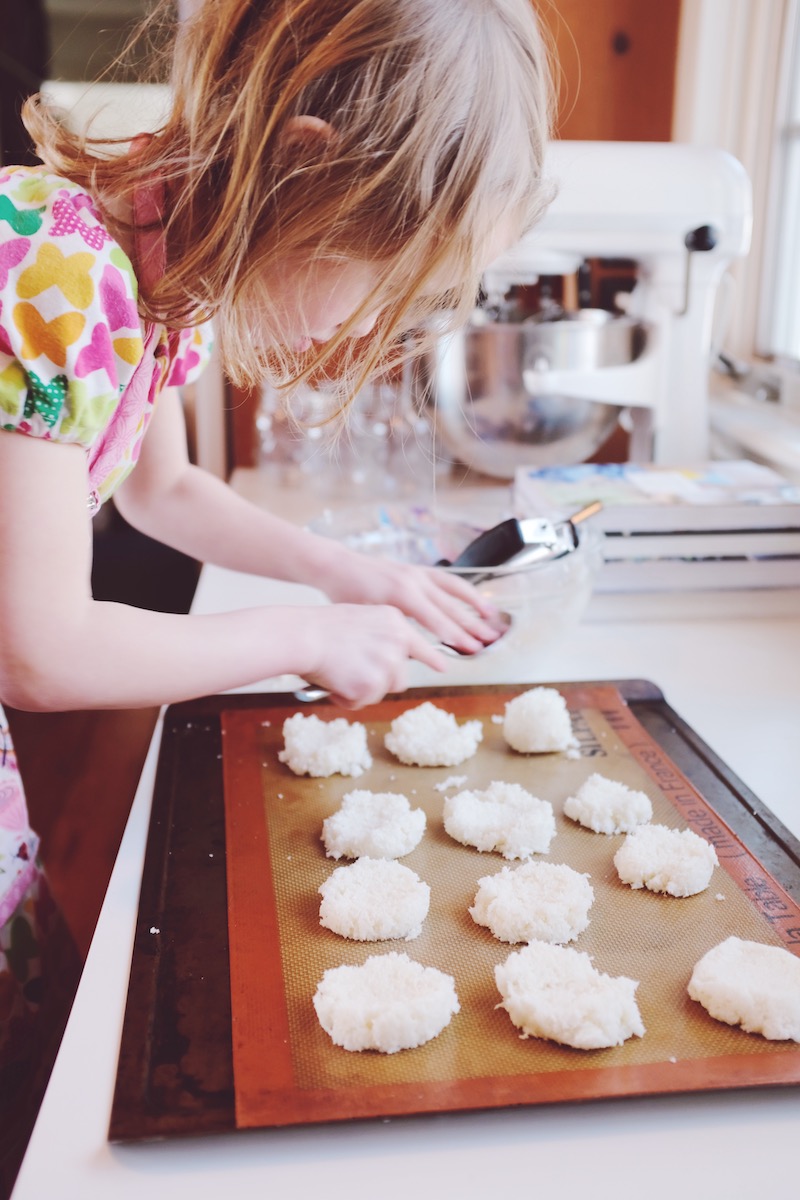
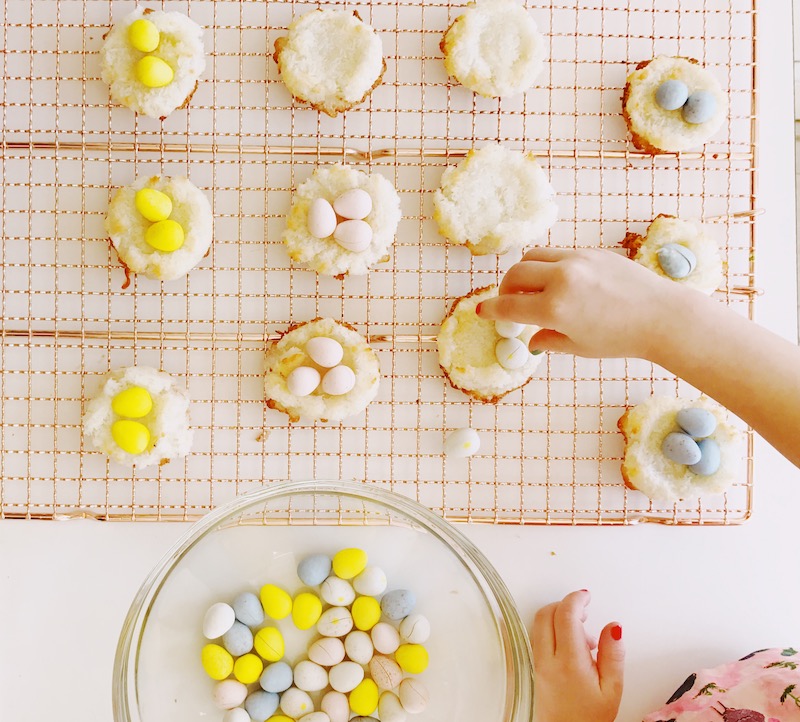
-
a no-drama guide to bullet journaling
When I realized my friend Kate was three years into her bullet journaling habit, I couldn’t resist asking her to elucidate her method and approach for us. There’s something truly remarkable about mixing the daily practical schedules of a mother, a devoted school librarian, and an ambitious household manager alongside the grander schemes of a young woman’s mind and the interests of an omnivorous pop culturist. I loved getting this peek into the inner workings and I hope you do too.
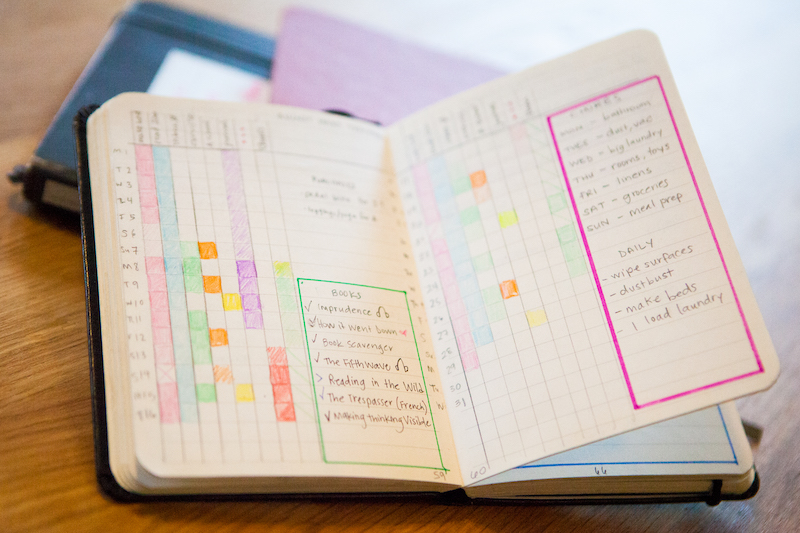 by Kate Bowman-Johnson. Photos of Kate’s journals by Leah Hood.
by Kate Bowman-Johnson. Photos of Kate’s journals by Leah Hood. Recently, in the middle of an intense counseling session, I found myself breaking out my planner: Exhibit A.
“This is what it’s like inside my head all the time,” I told my therapist. “There’s no rhyme or reason, half of it’s indecipherable, there are pages of incomplete tasks, and there is a lot of space devoted to bad television.”
She flipped through the journal slowly. “Okay,” she said, “but I also see illustrations by your kids. There’s some beautiful art in here. I see a lot of tasks crossed off. I see smart workarounds, sermon notes, and a list of what’s making you sad. It seems like this journal helps you manage your mental health in a productive way. I don’t look at it and see someone who’s failing.”
Well. A more on-the-nose introduction to this piece I could not have dreamed up. Fellow havers of mom-brain and assorted mood disorders: welcome to Bullet Journaling as Therapy. Less a fun tutorial, more a reflection on how a book and pencil saved my sanity – and just might save yours.
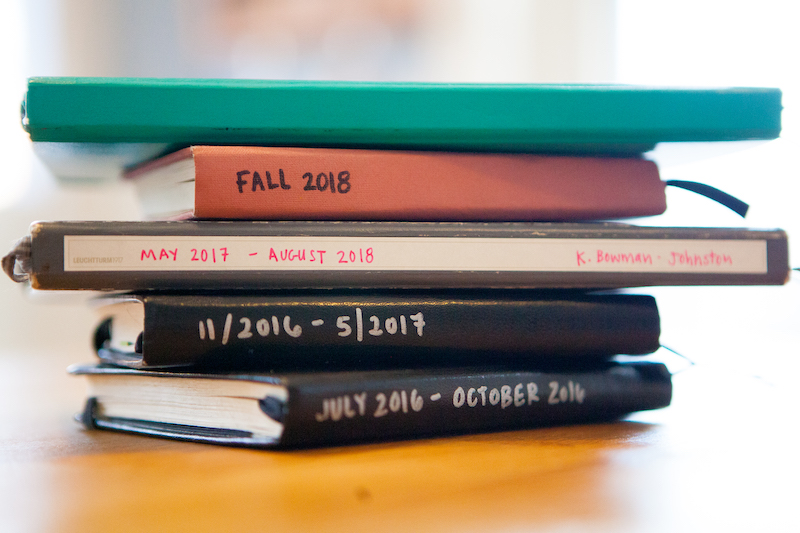
I started bullet journaling three years ago during a particularly busy season in my life. I had two young kids, I was a year into an exciting but whirlwind job, and I was actively fighting depression and anxiety. I kept forgetting important dates and dropping the ball. Post-it notes were stuck to every surface. I had three different Google Calendars, none of them synced. Sometimes I would write things in a Moleskine, then lose the Moleskine. It was bad.
I don’t remember exactly how, but I stumbled on a video about bullet journaling from the method’s creator. It immediately hooked me because of its simplicity, adaptability, and clear organization. I liked the balance between freedom and structure, two poles between which I’m constantly pulled. It seemed just the thing for someone like me, who’s equal parts fastidious and forgetful, creative and downright lazy.
So I grabbed a small notebook I already had on hand, watched some more videos, read some more tutorials, and set up my first bullet journal with only a Ticonderoga pencil in hand. (As an educator, I’m here to tell you that no other pencils need apply. Some things are worth the brand name.)
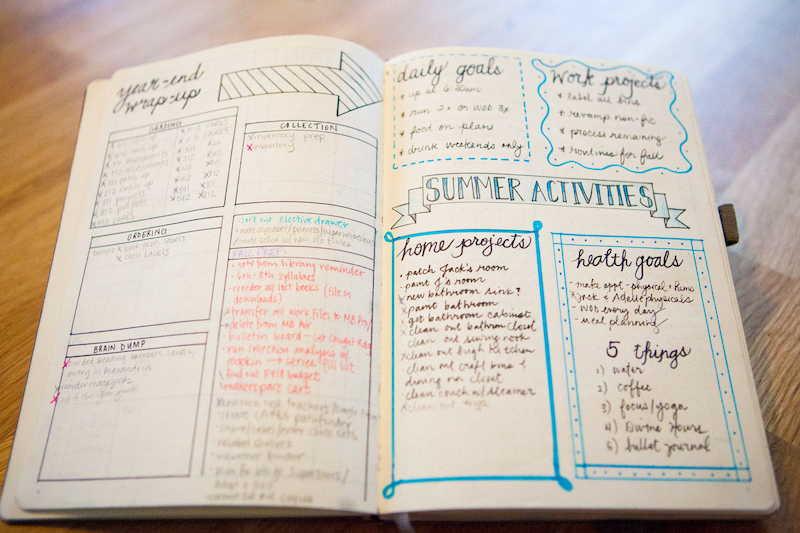
Three years in, bullet journaling is one of the few things in the universe that has not only lived up to the hype, but proved sustainable for me. It’s transformed my busy life and busy brain. It’s a way to self-soothe when I feel like things are falling apart around me; if I can capture them in the moment on paper, they’re not so daunting. They’re contained, yet accessible at all times. Mischief managed.
Since I began in 2016, much has been published about bullet journals and their Pinterest-ready cousins, dot journals. There are endless articles about how to set up your journal and embellish your journal and invest your fortune in stencils and washi tape. Such tutorials have been very useful to me (this one by Rachel Wilkerson Miller is the gold standard, if you want to familiarize yourself with the basic tenets, and I also like her book Dot Journaling: A Practical Guide), but the market is saturated. Instead, I hope to share a few guiding principles for people who are looking for more than just, as Rachael so aptly put it, a “relentless to-do list” – but may feel overwhelmed by getting started.
Flexibility is a feature, not a bug. Since you create a bullet journal by hand in a blank book, one page at a time, you can do literally whatever you want. Which is terrifying for someone like me. There is nothing I like more than following rules (Enneagram 6!), so I’ve had to push myself to bend and break them – but mercifully, journaling is built for that. For example, I used a weekly spread for months before I realized it was stressing me out and got rid of it. The world did not end; my process just got more efficient. Similarly, you’re not “supposed” to set up dailies ahead of time – but making a new spread once a week isn’t realistic for me. I make them all at the beginning of each month and I don’t feel bad about it, because it works. Meanwhile, all of my sections are interspersed with the weird art my kids make while waiting at the doctor, random lists, recipes, project-planning spreads, etc. There’s no BuJo police and they are not coming for you. Do you.
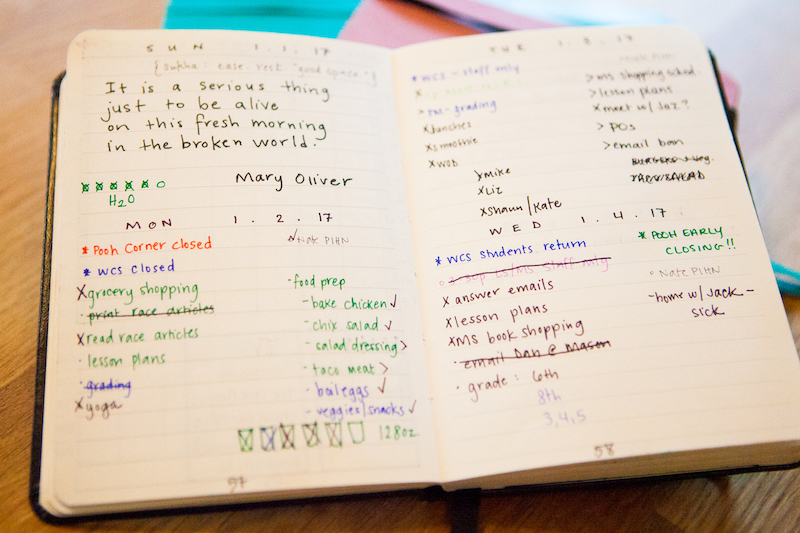
Keep the ‘gram at arm’s length. The internet is full of talented folks with gorgeous BuJo spreads and a lot of time on their hands. Their work is informative and inspiring, but take it with a grain of salt. Your bullet journal does not need reams of watercolor landscapes or brush lettering to work for you. Minimalist journaling is its own subculture, worth investigating if you get turned off by the fancy stuff. Personally, I check in on a few noted journalers once in a while if I’m feeling stagnant or need specific layout ideas. But by and large, I try to view those accounts as pure eye candy – not an indictment of how much I suck at planning and/or art. My own journals run the gamut from painstaking brush-lettering to hastily dashed grocery lists; it all depends on how much time and energy I have on hand.
Let accessories take a backseat. I know it’s tempting, because there’s so much cute stuff out there, and it’s so cheap on Amazon. As someone guilty of buying up hobby gear only to abandon it two weeks in, I forced myself to try bullet journaling for a whole month with only the resources I had on hand (journal, pencil). Then, once I had a better idea of how I was using it, I invested in a few simple tools: a small metal ruler, reusable page markers, and erasable pens. Years later, I’m the proud owner of some Tombow brush pens and layout stencils, but I usually default to a simple approach because it keeps the focus on the content.
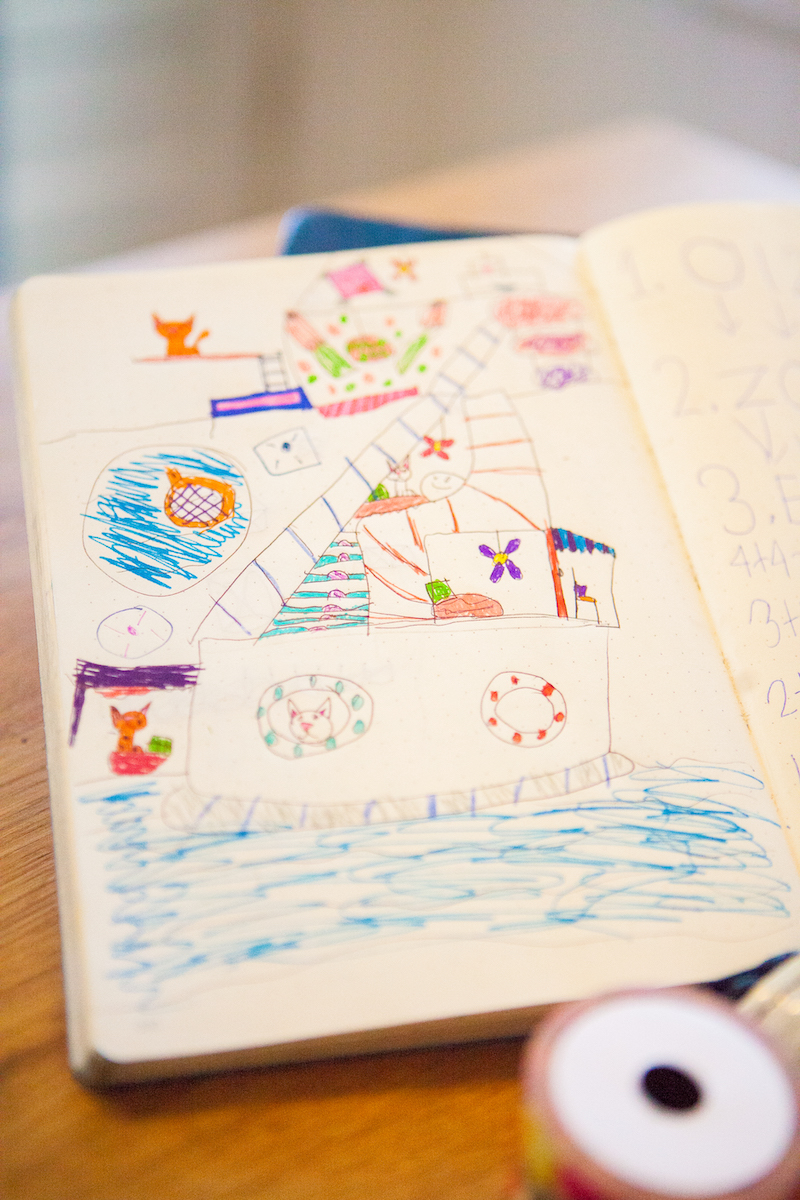
Find a balance with digital tools. When I upgraded my phone, it had an unexpected effect on my journal. I found myself abandoning the habit trackers that make dot journals so pretty, but they had become superfluous now that I had apps. Clue hacks my cycle; YNAB tracks expenses; Noom covers nutrition and exercise – so those stay in the cloud. On the flip side, I still put TV shows I’m watching in my journal (I’ll explain why in a minute), and I also meal plan on paper. The only things I duplicate are calendar appointments – hand writing them sears them into my memory, but I also need those automated pings and dings from my phone – and my reading list, which I keep on in my journal as well as plug into GoodReads. Otherwise, the division of labor is pretty clear. Don’t make your journal work harder than it needs to just for the sake of looking impressive!
Write it all down. One of my favorite BuJo functions is that of a lazy diary. When we’re on vacation, I summarize each day’s highlights, as well as recording impressions from daily life as I feel the urge. Samuel Pepys I am not, but I do like having a record of what I was thinking or feeling at a particular moment. When my kids ask about an event (“when did I find that dead mouse in the bathroom?” was a fun one), I’m just as likely to flip through old bullet journals as I am to scroll through my Instagram feed to track it down. This is also why I write what I’m reading and watching and listening to – they’re snapshots not just of the media I consume, but landmarks in time. Nothing is too big or too small to diarize alongside your to-do list, because it all creates opportunities for reflection later on.
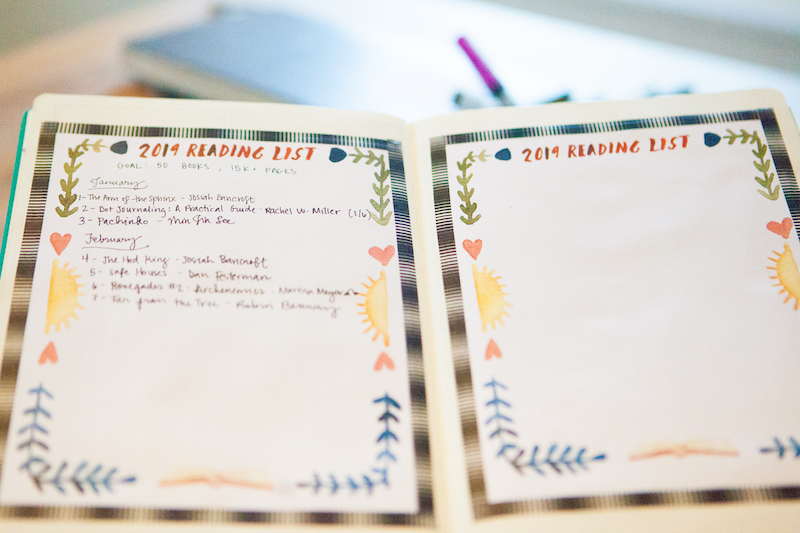
It’s okay to be aspirational. Listen. I’m sitting here telling you to be cool and not overdo it with your bullet journal, when I know full well this book sitting right next to me is slathered in washi tape and spreads designed by a professional artist and all kinds of pretentious shit. The old journals piled under it are filled with trackers I made with high hopes of developing life-changing habits… then abandoned. It’s all part of the process. A few years back, I hosted a lengthy bullet journal discussion thread on my Facebook page, in which several friends noted with envy my list of daily and weekly chores. I assured them that said chores were ambitions, not realities. I record lists like this so that I don’t waste time dithering around, wondering what to do and where to start, but so that I have something concrete to tackle when the opportunity arises. Indeed, a bullet journal can be as spare and minimal as you want – but if filling it with designs or itemizing your dreams in a spread brings you joy, go for it.
The takeaway here is that a bullet journal is not a magic, er, bullet. It will not effortlessly transform you into a totally organized, together person. Like most things, you get out of it what you put into it. If you’re looking for structure with a dash of free will, if you need a home for your fascinations and foibles and lists titled “Where Did I Hide That Thing From Myself,” bullet journaling is a good place to start. If nothing else, you can use it for show and tell at therapy.
-
Bookshelf Godmothers
My friend Jenny has been homeschooling her five children from the beginning. From afar I’ve watched as her confidence and spirit have flourished in her approach. I know her as a deep thinker and researcher, so I knew she must have a heavy bookshelf of guidance and encouragement in this journey (in particular I liked imagining her on her porch, deep North Carolina summer, glass of iced tea, notepad, and books at her side).
I asked her to share the top titles with us, the bookshelf-godmothers of her approach, and she did! There is so much wisdom here. Thank you Jenny! Illustration by Joe.
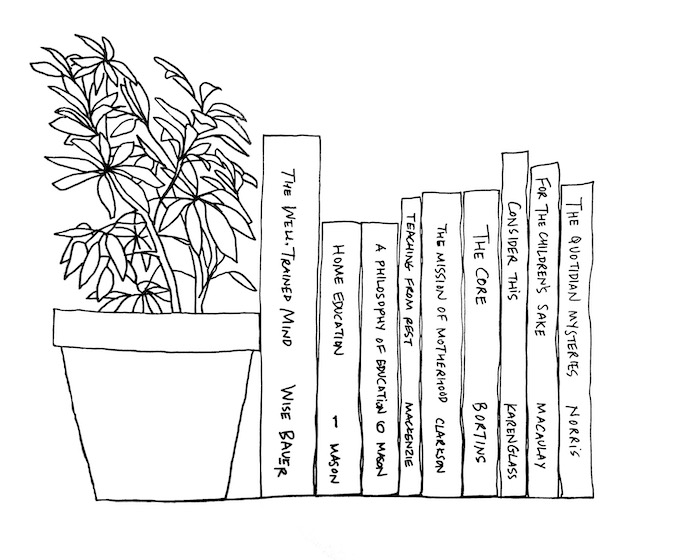
Homeschooling sort of stumbled into my lap. I never planned to be here, and I don’t know much about what the future holds. We just do the next right thing. We’ve settled now into a classical, Charlotte-Mason, history-loving, nature-school hybrid that I’ve dreamt up with my husband of 11 years. We have 5 children, a handful of chickens, 1 dog, 2 cats on 4 acres in the woods near Charlotte, NC. My husband is a financial advisor by day, homesteading park-ranger by night. We love nature and books, food and bonfires.
We have a mixed bag of influencers. Being an analytical mind and extensive researcher, I feel the need to read all the books. I enjoy the overwhelming feeling of so much good. All these women, going before us; leading the way and training us with their wisdom.
- Our first influencer, the Headmaster, Susan Wise Bauer of The Well-Trained Mind
- This is the comprehensive guide to classical education outlining the history of the methodology as well as implementation. The three stages of classical education are then thoroughly discussed by grade and subject. The book-lists alone are worth copying down. The last section discusses how to implement classical education at home, managing the records, tests and schedules, etc. No coddling. She gets right to it. Her way is strict, demanding, specific, and extensive. I open this book every summer when I’m planning my year and re-read each section for my specific child’s needs. I order most of her recommendations and haven’t been disappointed once. The Bauers and the Well Trained Mind have a large presence in our home. We’ve used:
- Story of the World– all four volumes and workbooks. Elementary history chronologically and geographically written so well.
- The Ordinary Parent’s Guide to Teaching Reading– an open-and-go phonics program. Simple and straightforward. We’ve used it for years.
- First Language Lessons– An open-and-go classical grammar and language arts program for the early elementary years.
- This is the comprehensive guide to classical education outlining the history of the methodology as well as implementation. The three stages of classical education are then thoroughly discussed by grade and subject. The book-lists alone are worth copying down. The last section discusses how to implement classical education at home, managing the records, tests and schedules, etc. No coddling. She gets right to it. Her way is strict, demanding, specific, and extensive. I open this book every summer when I’m planning my year and re-read each section for my specific child’s needs. I order most of her recommendations and haven’t been disappointed once. The Bauers and the Well Trained Mind have a large presence in our home. We’ve used:
- Charlotte Mason, specifically, Home Education Vol 1 and A Philosophy of Education Vol 6
- Here we have our wise, wordy grandmother. Using her philosophy, she led schools and trained teachers in England (in the early 1900’s). Her basic premise is best summed up in the phrase, “Education is an atmosphere, a discipline, a life.” Some of my favorite topics covered in these two volumes: living books, habits, whole living ideas, nature study, a child’s mind as an organism, a full and well-rounded curriculum full of the ‘riches,’ using short lessons to encourage interest and eliminate boredom, and how stories build character. Anyone who is interested in not doing ‘school at home’ but real and vibrant homeschool, opposite of brick-and-mortar school should consider reading both of these volumes (or all 6!). Our students are spirits to be kindled, after all.
- Sally Clarkson The Mission of Motherhood and Educating the Wholehearted Child
- If I had to choose a fairy godmother, I would choose Sally Clarkson. She has the tender loving, sweet-talking, supportive air about her. She has written a myriad of books and they range from topics of motherhood in general, homeschooling, homemaking and more. These two are my favorites. The first is an affirming, spiritually-rich encouragement for the calling of motherhood. It reminds us that our primary role as parents is the development and molding of our children’s hearts for God. Teaching them (even if we don’t school them) to tend their passions, habits, words and actions towards being faithful to God is our ultimate destiny for these short years we have them at home. The book is a yearly must-read for me, even if I just skim or read my underlining. After I close the book, I have a renewed sense as a mother. I’m more patient, calm and hopefully, more aware of being with my children instead of just managing them.
- Educating the Wholehearted Child is a homeschooling-rich resource. It outlines how the Clarksons homeschooled and how they used living books and various curricula. They discuss discipleship and use that as a term that is a good reminder for creating life-long learners modeled after Jesus’ teachings. The book reads like a textbook and is an aid for beginners as it details various homeschooling methods, curriculum and resource lists.
- Other books by Sally that I’ve read and recommend: Desperate (encouragement for the weary mom), The Lifegiving Home (yearly ways to make your home unique, inviting and traditions to uphold), and Seasons of a Mother’s Heart (a gentle reminder to take care of yourself and that certain season are more difficult than others).
- Sarah Mackenzie Teaching from Rest
- Sarah Mackenzie would also be a fairy godmother if we’re allowed two. Or a fairy aunt. She is young and still in the trenches with toddlers and students afoot. Her book is a short but concise view of the mental challenge of teaching from rest and from a space of low-anxiety. She gently reminds us who it is we are working for (God) and what is required of us (faithfulness). “The heart of this book is about remembering what our true task really is and then throwing ourselves in completely. Giving our all. The raising of children, the teaching of truth, the sharing of life, the nourishing of imagination, and the cultivating of wisdom: these are all his anyway, we are merely His servants.” This is a must-read for any new or harried homeschooler. (Her website/podcast is also full of book list nuggets and interviews with some popular authors www.readaloudrevival.com; She also has a new book out called The Read Aloud Family.)
- Kathleen Norris Quotidian Mysteries
- This one won’t show up on many homeschoolers’ radars but I consider it a yearly must-read. Kathleen Norris could be our spiritual mother and mentor. The subtitle of this very short but thoughtful read is Laundry, Liturgy and ‘Women’s Work’, and it enables us to recognize our quotidian (or daily tasks) as holy work. The repetition, the mundane and the potential acedia that takes years to overcome is all discussed in a poetic and personal tone. Dishes, laundry, mopping, brushing out tangles, all of these can be worthy as worship if done in the right spirit. This is not a homeschool book. Most days, though, the actual schooling is easy and the living is what drains me. This book convicts me to my core making me evaluate my heart and motivation. Our homes can be our monasteries. Liturgy, reading, housekeeping and constant prayer- as the Benedictines do, so do the mothers.
- Susan Schaeffer Macaulay For the Children’s Sake
- Susan Schaeffer Macaulay- a gently reminding sister. When I first came into the homeschooling arena, this book was recommended over and over to me. It is a biblically framed reminder to remove ourselves from the culture of schools and create an atmosphere of education in our home. It is a great read for the beginner, especially one who has littles at home. The pressure to start sometimes itches at us but our children need to be relieved of this. She’d say “Remember this: nourish our children’s lives and cultivate their souls.”
- Other notable recommendations: Leigh Bortins-The Core, Karen Glass- Consider This, Cindy Rollins- Mere Motherhood.
We can’t forget the men. Here are some notable Godfathers:
- C.S. Lewis- Abolition of Man
- David Hicks- Norms and Nobility
- Anthony Esolen- Ten Ways to Destroy the Imagination of your Child
- Oliver DeMille- A Thomas Jefferson Education
- Richard Louv- Last Child in the Woods
I’ve been wanting to read/currently reading: Stratford Caldecott- Beauty in the Word (amazing!), and Julie Bogart, The Brave Learner. Let us not become weary in doing good, for at the proper time, we will reap a harvest if we do not give up. Cheers to you on this long obedience; may your years reap a great harvest.
- Our first influencer, the Headmaster, Susan Wise Bauer of The Well-Trained Mind
-
List Therapy
Though we’ve never met in person, I consider Amelia a close internet friend, a longtime reader, and a woman of enormous wisdom and warmth that she can’t keep from effusing through her digital self. If I could convince her to write a weekly column for us, I would! But meanwhile, her presence on Instagram is a generous window into her humble, gracious approach to life and motherhood. In her essay shared with us here, I love the way the idealism of to-do meets elevation of memory.
It all begins with the right atmosphere. There should be a decent amount of time to think and write. A favorite pen is lovely, good posture allows for penmanship you can be proud of, and no children on your lap/on top of the table/trying to chew on your pen is ideal.
This doesn’t happen to me very often.
At this point in my life, I make lists in my head, in the quiet busyness of making beds and putting dishes away and in the pick-up line at school. I forget them all by bedtime. Still, somehow, even just thinking the lists, one by one, helps me. Like taking the messy pile of thoughts in my brain and clacking them on a desk till they form a tidy stack. I feel better, even if they eventually flutter out of my brain like leaves down the street.
When I do have time to write them down, I like to keep my lists in notebooks. By now I have enough of them to line a shelf in my living room. Though I’ve never been good at keeping a diary or organizing photo albums, I can crank out enough lists to fill a notebook in a matter of months, and flipping through those old notebooks provides the same kind of nostalgia as any diary could. Who needs journals full of thoughts and confessions when you can recall exactly how life was just by looking at a grocery list you made as a newlywed? One of my favorite notebooks holds all the lists I made as I transitioned to motherhood. One page has a list of last minute nursery tweaks, and the very next contains nothing but a column of feeding times, along with which side my newborn son fed from last. The handwriting is scrawled and crooked. The page itself is literally coffee stained. It is the most accurate time capsule.
I’ve been using list-making as a way to calm myself and sort my thoughts for years. I take it very seriously. Some lists are a comforting constant, and remain the same through the years: January lists are full of health goals and house projects and so much hope. Spring lists are all about garden plans and cleaning sprees. Summer lists are few and far between, and then August lists come with a vengeance and great detail. Parenting goals! Meal plans! School supplies! Vows to reinstate order after the wild days of summer. Then the cold, dark months come and the pages holding Christmas lists and Advent activities are decorated with stars, doodled to look as bright and twinkly as possible.
Some lists are new. For example, after six straight years of being pregnant and/or nursing a baby, I am suddenly not. So, in the spirit of my newfound freedom, I dared to make a short list of restaurants to try. Date night ideas! New territory.
Some lists are ever changing and growing. I have a To Read list, a Songs for a Good Cry list, a Things I Want My Husband to Build for Our House list. The Jobs I’d Maybe Like to Have One Day list feels exciting and scary, and my heart flutters when I add to it. I don’t know if I’ll ever create illustrations for children’s books or be a Home Economics teacher, but they’re on the list and I feel like that counts for something.
It’s easy to look through my notebooks and find the times in my life where I struggled. Almost two years ago my husband and I sold our house, moved to a small apartment with our children, and welcomed a new baby a few weeks later. The year that followed was the hardest of my life. My baby cried for months, I lived in an uninspiring place that did not feel like home, and I worried constantly that I wasn’t giving my children what they needed. I longed for a home, for some peace, for some sleep. I had no time for any sort of creative outlet, and all my emotions poured out into my lists. Oh, the detail of those lists! The order! The desperation. My handwriting was sharp and upright and eager, like if I wrote down what I wanted with enough gusto, maybe it would come. Those lists are hard to look back on.
There have been other moments of struggle where my lists lose order of every kind, and instead become long, flowing paragraphs of prayer. Prayers for myself and for loved ones. Prayers for health. Prayers for clarity and faith when I feel like I’ve lost my way. I love to look back on those lists, because they’re tangible evidence of prayers answered. Problems solved. Clearly, lists are a way I try to keep control of my life. But when I re-read these lists of pleading prayer, I’m assured I’m not really in control of any of it. Thankfully.
Over the weekend my daughter became very sick with a high fever. I accomplished nothing but the basics, fretting over temperature readings and trying to keep my hot baby comfortable. I did, however, manage to make one tiny list. It was actually more of a chart— two doses of amoxicillin for 10 days, Tylenol and ibuprofen, rotated, and the times administered. That small act of writing a list gave me a little bit of control when things felt out of my control. Some order when I was worried. A stacking of mental papers. She would be better, I knew. I wasn’t really in control of it anyway, thankfully.
But, of course, the list helped.
-
my hospital bag
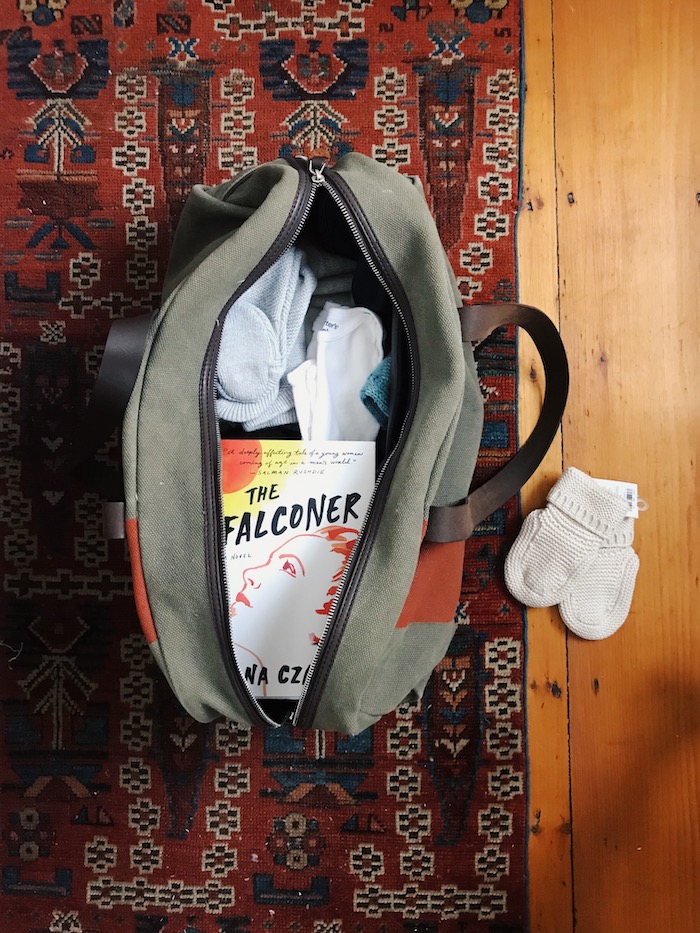
Arguably there is no better metaphor for a woman’s last grasp at self-perception before an infant than the hospital bag. Misguided, optimistic, generous, cautious—it all gets packed. My bag usually ends up being half snacks (turmeric cashews are a recent favorite and several variations of homemade granola that I could eat forever). This time I’m adding a fresh, uncracked novel.
And there’s plenty of room for error. Last time, I remember thinking we were fools not to pack several rounds of energy drinks for Joe’s hormone-free all-nighter. We’ll fix that this time. And last time, I packed lots of chocolate granola, which was delicious, but also kept me up after I ate it all up at 4 am after Alma’s birth. As I type that I realize the irony: energy for myself at the wrong time, no spare bottled energy for my partner at the right time.
It’s something akin to the old saying for a woman’s wedding composition: something old, something new, something borrowed, something blue. In place of something blue, I’d say something gently inspiring that reminds you can have a baby–whether because you did already or you simply believe that you can or someone else, like Ina May Gaskin, believes you can. This time it will be a necklace Joe gave me that has a tiny circle for each girl’s first initial. Can you believe I have four tiny pendants gently resting? Something new for me is a cozy set of sweatpants and sweatshirt that I know will feel wonderful to pull on afterward. Something old: so many things, but namely tattered slippers. Something borrowed: there are always things to reuse or borrow back in an infant’s collection of textile. I like taking arnica tablets in the days right after birth. And chapstick and face oil always seem to become rare and precious ointments in industrial-airway buildings.
Do you have favorite memories of mishaps or perfectly-packed?
-
review // Home Grown: Adventures in Parenting off the Beaten Path
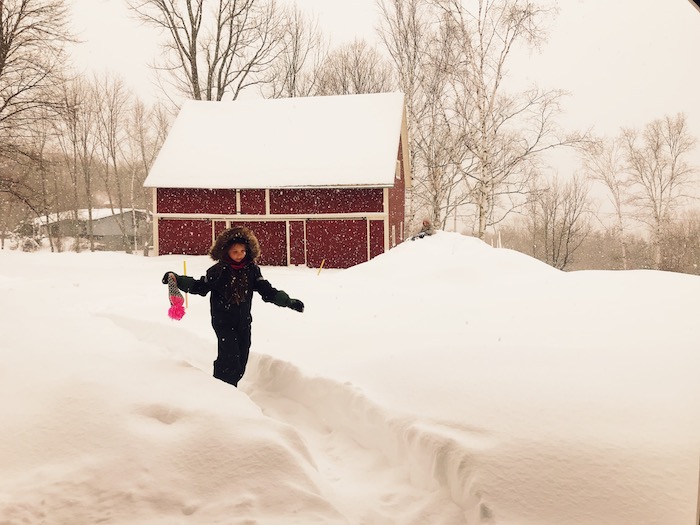
I just finished a forest school book that was so nice I’d like to read it twice. Maybe I will. It was one of those wonderful reads where you get to live in someone else’s life and soak up their lessons and foibles, their mistakes and ambitions, all from the sequestered comfort of your home that looks nothing like theirs. Here’s how I came upon the book…
A few years a guy by the name of Ben Hewitt wrote an article for Outside Magazine about unschooling. I read it through a couple times and deemed it a steaming cup of bone broth from the unschooling movement. Here’s just a paragraph or two…
By 6:30, with the first rays of sun burning through the ground-level fog, the boys are outside. At some point in the next hour, a yellow school bus will rumble past the end of the driveway that connects the farm to the town road. The bus will be full of children the boys’ age, their foreheads pressed against the glass, gazing at the unfurling landscape, the fields and hills and forests of the small working-class community they call home.
The boys will pay the bus no heed. This could be because they will be seated at the kitchen table, eating breakfast with their parents. Or it might be because they are already deep in the woods below the house, where a prolific brook trout stream sluices through a stand of balsam fir; there is an old stone bridge abutment at the stream’s edge, and the boys enjoy standing atop it, dangling fresh-dug worms into the water. Perhaps they won’t notice the bus because they are already immersed in some other project: tillering a longbow of black locust, or starting a fire over which to cook the quartet of brookies they’ve caught. They heat a flat rock at the fire’s edge, and the hot stone turns the fishes’ flesh milky white and flaky.
I immediately googled what else this guy had written, and requested his book Home Grown. It is a quieter read than the article. While the article is edited to entice, and also, yes, to provoke, the book is a thoughtful read on the endearing attempts of unschooling parents to guide and provide for their children, to be patient, to believe in themselves and their child, and their children’s recent habit of skinning skunks in the front yard. It reminded me of Wendell Berry–written in a softly humble tone by a man who is grateful and astonished to find himself supporting his family above the poverty line as a writer and farmer.
Though we may now live surrounded by trees, rest assured my children are not (yet) hunting squirrels with handmade bows or building their own maple sugaring fires. They do not wake at dawn, dress appropriately for the weather and leave the house for hours at a time. And we aren’t unschooling. We are decidedly full of workbooks and curriculum and goals. But in reading something like Home Grown I can learn a lot from his attitude, the reminder to take the extra time to let them learn alongside you, the power of wait-and-see.
It has also been on my mind to seek out a tutor of sorts who could wander the woods with the girls, so I was delighted to find this same idea working well for Ben’s family. There are loads of wonderful camps around us, but I don’t need a week of intense activity framed by long drives and packed lunches. I would love something regular in our backyard with someone who can evolve into a mentor and friend.
What about you? Any good education reads lately?
-
old love // new love

I’ve got pencils on my mind for Valentines. Pencils are a delightful part of everyday life around here with the girls laboring over their handwriting–sharpening beautifully, the erasers all worn down to courageous stubs (furious erasing takes such courage).
I am the parent-tutor for a class of six seven-year-olds, we’re together each week for three fun and challenging hours. I will give them each a bright red sharpened pencil and a delicate red pen, the nib type that bends if you push too hard but until then, draws the most perfect fine line.
There is just something about red in February.
In the evenings the girls and I have been reading Birchbark House, a fictional story about a historic Native American tribe living on Lake Superior. We have landed in the winter chapters. The seven-year-old heroine Omakayas, her sister, mother, and grandmother spend the winter carefully beading projects like moccasins and purses by the dim firelight.
My equivalent is slowly beading our photos from 2017 and 2018 into a complete book for each year, purging hundreds of photos from my computer as I go. Last year I forgot to do the book for 2017. I think house hunting took over that computer-use space. Ultimately I have a very limited patience span for computer-ing. If I have one project, the time does not expand to accommodate another. It’s either/or.
Since 2013 I’ve used Artifact Uprising for my printed books; lured, I suppose, by their matte printing and rich papers. For years they did not offer an option for any kind of text to accompany the photos, which meant the book actually got done (they offer a text option now, which I will pragmatically ignore).
Their online book-building software is better than ever these days, they’ve fixed almost every quirk I used to quietly complain about. I recommend it. I also recommend batching all of your photos into folders by month and uploading the months as individual galleries. There–you have all of my wisdom gained in the last five years.
Though I was disappointed to find myself two years behind on the photo books, I have loved working through the photos from 2017. It’s completely wonderous how much has changed in that short amount of time. How much we did. How lovely most of it was. As I edit I often remember to murmur to myself–today we’re as young as we’ll ever be.
Bouquet image above from C.W. Pencil Enterprise.
 by
by 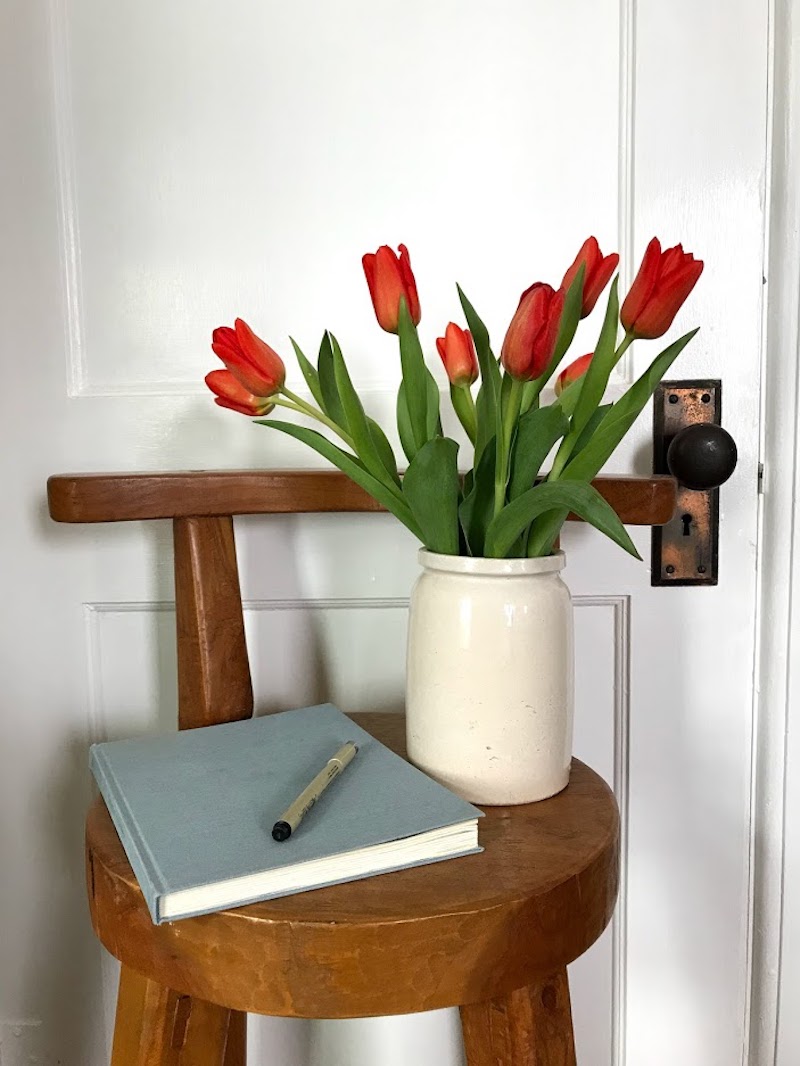 by
by